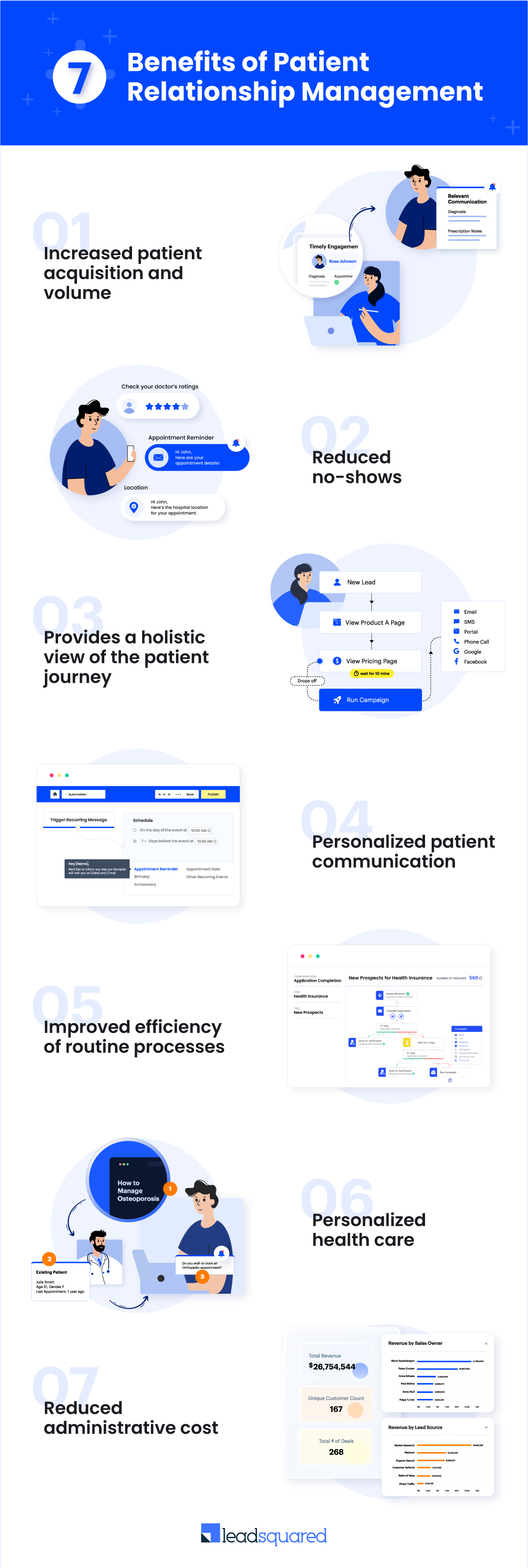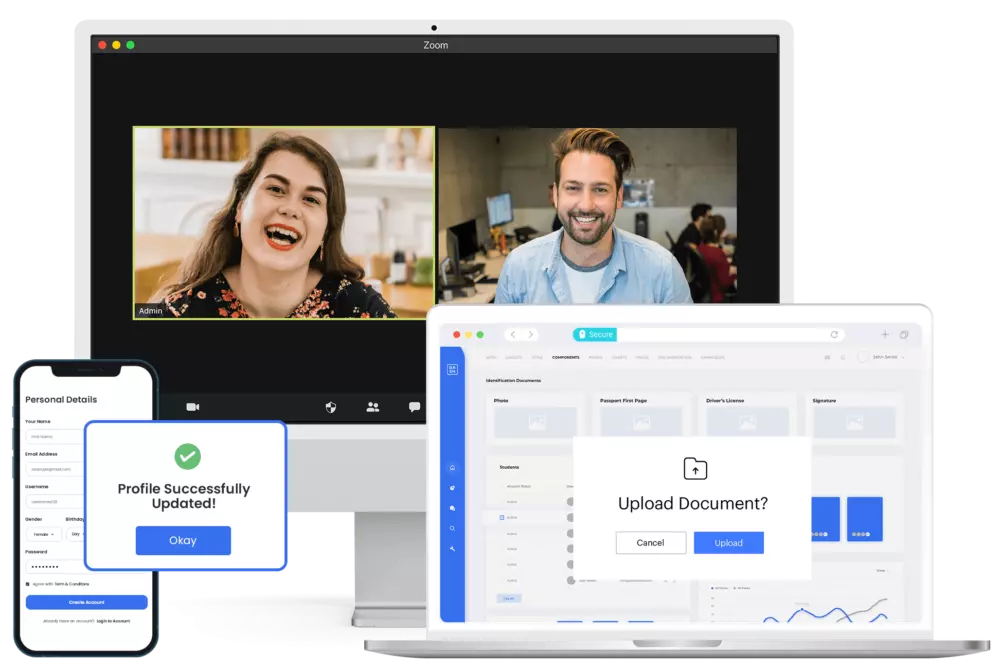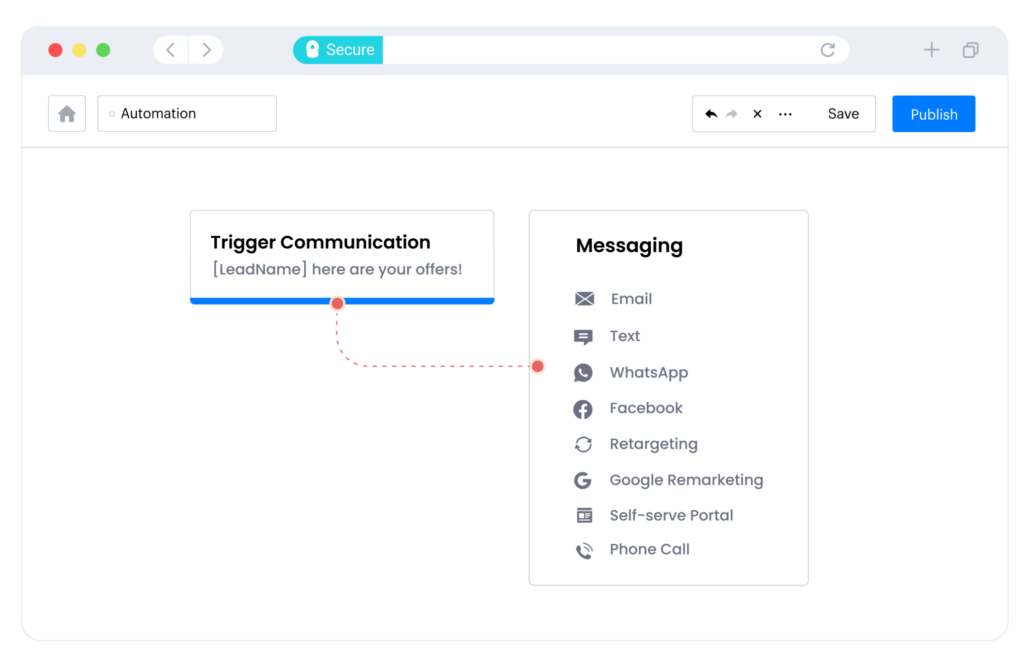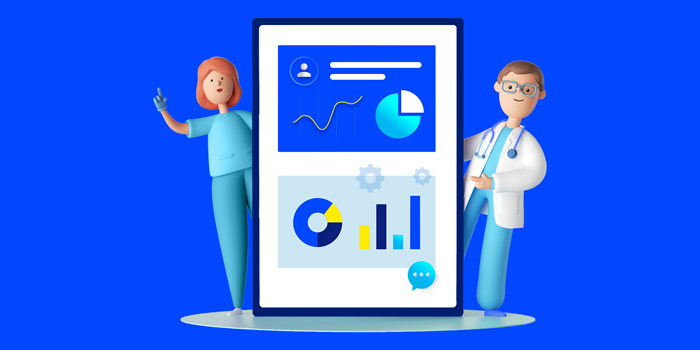As a healthcare organization, do you only have a transactional relationship with your patients?
If yes, it is time to rethink.
Patients today demand more than just care; they look for experience. They want to be heard, seen and receive personalized care.
But with multiple touchpoints during a patient journey, how does one make it personalized?
Patient relationship management is the key to it!
A PRM system does more than mere data collection. It provides a complete view of the patient’s journey, enabling healthcare providers to deliver personalized care.
It improves the overall patient experience, ensuring success for a healthcare organization. Forrester predicts the PRM market to grow to $889 million by 2025, which represents a CAGR of 14%.
This article will cover everything from patient relationship management and its benefits to how to pick the right PRM system for your healthcare organization.
Let’s first understand what a patient relationship management system means.
What is patient relationship management (PRM)?
Patient relationship management is an organized and planned way to maintain the relationship between the patient and the healthcare provider. The goal is to build long-lasting relationships with patients for better patient satisfaction and more referrals.
A patient relationship management system captures patient information and enables healthcare providers to access it anytime. It collects patient data throughout their treatment to give a consolidated view of the patient’s journey.
Patient communication becomes easy by having the patient journey tracked on one platform instead of being spread on multiple Excel Sheets and isolated systems.
Overall, a PRM system enables healthcare organizations to make data-driven decisions, provide personalized care, and improve healthcare outcomes.
Now that we know what a PRM system is, let’s dig into the benefits of implementing a PRM system.
Why do you need a patient relationship management system?
Excel sheets may look like a good option until the number of patients to manage is low. Once you start scaling and the flow increases, adding extra human resources will only increase the cost and reduce efficiency.
Not implementing a single platform to track the entire patient journey can present multiple challenges. For example:
- Process inefficiency due to manual work
- The increased cost of patient care
- Risk of the wrong diagnosis
- Poor communication between patients and healthcare providers
- Inadequate transfer of data between departments
- Poor healthcare outcomes
- An overall decline in patent experience
The list of challenges can go on, but don’t worry, this is why we are here. Let’s consider in detail the benefits of having a PRM system in place.
Benefits of patient relationship management

1. Increased patient acquisition and volume
Today, patients have multiple options around them to avail healthcare facilities. So how do you stand out in this competition? By providing a better patient experience.
Easy appointment booking and addressing their inquiries on time ensure you have a positive in-flow of patients. Building good relationships with patients will also increase referrals.
2. Reduced no-shows
No-shows waste resources and time for any healthcare organization, eventually leading to revenue loss. An analysis showed that sending automated and timely reminders for an upcoming appointment increased confirmation by 156%.
3. A holistic view of the patient journey
Losing patients during their journey is prevalent due to faulty systems. A PRM system tracks and collects data at every touch point to give a complete view of the patient journey.
By fixing the steps for leakage, you can improve the overall conversions for the organization.
4. Improved efficiency of routine processes
A PRM system can enhance the efficiency of routine processes like patient onboarding, referral management, and discharge. It helps you to identify unnecessary steps and eliminate them.
To save time, you can also automate low-value and repetitive tasks like data entry. It gives healthcare providers more time to focus on patients, improving patient satisfaction.
5. Better patient communication
A PRM can automate and personalize communication with patients. By storing the patient information marked into different categories, you can send targeted communications to your patients.
For example, sharing lifestyle tips with diabetic patients or informing women about the upcoming free breast cancer checkup.
6. Personalized care
A PRM system allows you to personalize patient care. It provides customized care and interactions by recording their medical history and details from past consultations. This improves patient experience and overall satisfaction.
7. Reduced administrative costs and increased revenue
A PRM system helps reduce administrative costs by saving time and resources for delivering specialized care. Many organizations have observed increased overall revenue after implementing a PRM system.
To get the full benefit from a PRM system, it is crucial to pick the right one. We have listed a few steps below, which will help you choose the perfect solution for your organization.
How to build the right patient relationship management system?
Patient relationship management is a broad concept. It is a combination of different features. Sometimes all of them are present in one tool, or various tools or systems are combined to build the PRM system.
Some general examples are appointment scheduling, inquiry management, information system, billing or finance tool, automation tools, etc.
Amidst all these options, how does one build the perfect PRM system?
To help you here, we have compiled a list of steps to guide you in implementing a PRM system in your organization.
1. Analyze your existing process and understand your needs
Before you go tool shopping, understand your organization’s needs and goals. For example, if your goal is patient acquisition, you need to start by improving your inquiry management and appointment booking process.
This means you need a system to digitize the process by creating digital patient profiles and providing a portal to book appointments.
Now, if you already have an appointment booking system, the goal is to improve its efficiency. You will need a system to automate the process and save time.
Similarly, analyze all your departments and process efficiency to create a list of organizational requirements. The goal is to improve the patient experience throughout the patient journey and build long-lasting relationships.
2. Include your key stakeholders
“The right system is not just the one you choose, but the one your employees willingly embrace and use to drive success.”
Richard Branson
It is essential that you include your stakeholders of different departments in the decision-making process. Since they are the ones who will know the pain points of their department and which system will be the best fit.
For example, your IT department will focus on data security and guide you to pick a HIPAA-compliant system. They will make sure your organization and patient data is safe and secure.
3. Research for the right product
Today, multiple tools are available for each step of the patient journey, like appointment booking, patient onboarding, communication, etc. Conduct exhaustive research on the PRM systems available in the market. Evaluate elements and ask questions like:
- What are its different features?
- Is it compliant with all the regulatory guidelines?
- How secure is your data?
- Is it easy to use? Will it require separate training?
- What are the integration possibilities?
- How easy is it to scale?
As this is not a one-day process, take your time to find a solution that answers all the questions.
4. Define your budget and expected ROI
Once you start looking for PRM systems in the market, you will get multiple options, and the expensive one is not always the right one.
You must first decide on a budget and then pick the best PRM system that fits in. It is also best advised to take into consideration your expected ROI while deciding.
5. Check for regulatory compliances
In healthcare, there are multiple regulatory compliances to keep sensitive patient data safe and secure. All healthcare organizations need to follow these regulations.
Look for tools compliant with laws like Health Insurance Portability and Accountability Act (HIPAA).
All of these factors make for a good PRM system in any organization. And one such example is Form Health’s, when they picked LeadSquared as their PRM system.
Let’s see how impactful it was for them.
How LeadSquared helped Form Health build a patient-first process
Form Health provides remote and personalized services for medical weight loss.
Onboarding a patient at Form Health requires a series of touchpoints and with ever increasing demand, they realized their ability to onboard and serve patients wasn’t keeping pace.
As their process relied on disparate tools and google sheets, the team found it difficult to process the data and fetch insights from it.
Form Health implemented LeadSquared for multiple processes like lead management, referral management, and patient engagement. They got a holistic view of the patient’s journey on one platform.
To get yours,
“LeadSquared checked all the boxes. Our team that does the patient onboarding tell me a great weight has been lifted. The difference between where we were and where we are now with LeadSquared is night and day.”
Jake Butler, Head of Product, Form Health
[Also read: Form Health Steps-Up to Meet Demand with Patient-First Processes to know the complete story.]
Key Reports:
Sales and marketing Goals | Leadsquared Solutions | Results |
Seamless patient onboarding | One platform to manage patient engagement and details | Improved patient onboarding |
Improve lead management | Capture leads from multiple sources and automated distribution | Reduced response time |
Improve lead nurturing | Marketing automation workflows | Improved patient acquisition |
5 features of patient relationship management
1. Patient intake automation
Capture patient inquiries and appointment booking requests from all your online sources (website, healthcare aggregators, paid ads), phone calls, and walk-ins seamlessly.
With LeadSquared, you can automate the distribution process and assign the inquiry to the right department for follow-ups and increased conversions.
At the same time, streamline patient data to reduce response time and provide quick solutions to inquiries.

2. Lead and task management
LeadSquared provides a 360-degree view of the patient journey. It helps you track progress at every step of the patient journey. You can manage all the leads and tasks on one platform.
You can automatically assign tasks and notify your staff to email or follow up with the patient.
Manage your team and processes by creating multiple workflows for teams and functions like physician onboarding, sales, marketing, and operations.
3. Marketing automation
LeadSquared helps you automate your marketing campaigns to maximize the ROI.
You can gain insights into your patients’ behaviors, preferences, and needs to tailor your marketing campaigns and reach the right people with the right message at the right time.
Tracking and analyzing your marketing efforts and identifying the campaigns generating the most ROI becomes easy, which in turn helps you make data-driven decisions to optimize your future campaigns.

4. Communications management
LeadSquared enables you to initiate relevant, personalized, and contextual conversations with patients. You can improve retention rates with recurring event communication like appointment reminders, follow-up schedules, and more.
5. Reports and Dashboards
LeadSquared provides 100+ ready-to-use dashboards for lead source, referrals, pipeline, revenue by location, and more.
You can use these dashboards for tracking daily, weekly, monthly, quarterly, or yearly progress.
All the dashboards and reports support click-through functionality to expand details.
The reports and dashboards will help you reduce patient acquisition costs and increase operational efficiency with real-time, actionable reports.
Conclusion
Patient relationship management is a crucial element for a successful healthcare organization. It allows them to meet patient expectations and deliver personalized care.
A PRM system will help you improve patient communication and overall healthcare outcomes.
Investing in the PRM system will help you build long-lasting relationships with patients. It will make them feel you care for them throughout their healthcare journey.
LeadSquared provides a one-stop solution for all your patient relationship management needs.
To learn more about how you can improve patient experience and your team’s efficiency, get in touch with our team today.
FAQs
1. What is PRM for hospitals?
A patient relationship management system designed especially for a hospital helps analyze interactions between the hospital and patients. The goal of a PRM in a hospital is to improve patient satisfaction and get more referrals.
2. How is a PRM different from a CRM?
Organizations across industries use CRM to analyze customer interactions to provide better services.
Whereas patient relationship management, or PRM, is used in healthcare to analyze a patient’s journey to build a long-lasting relationship and get better healthcare outcomes.
3. How does PRM benefit hospitals?
A PRM benefits a hospital by improving the relationship with patients and increasing revenue.
With a PRM, a hospital can gain a 360-degree view of its patient journey. It provides easy access to patient data so that you can drive insights to make data-driven decisions.









